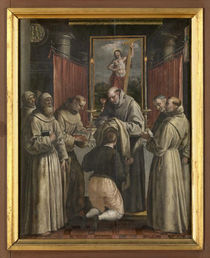The Catholic Defender: Saint John I
- Donald Hartley

- May 18
- 2 min read
Updated: May 19
Deepertruth with special permission and aid with Franiciscan Media, a great team for the Lord

Saint John I, (born, Tuscany [Italy]—died May 18, 526, Ravenna; feast day May 18), pope from 523 to 526. He ended the Acacian Schism (484–519), thus reuniting the Eastern and Western churches by restoring peace between the papacy and the Byzantine emperor Justin I.
Successor to Hormisdas
Though old and frail, John was elected pope in succession to Hormisdas I (514-23). Hormisdas had been successful in getting the “two natures/one person” doctrine on Christology accepted in Constantinople especially by the then no-nonsense emperor Justin against the Monophysite view which had always tended to be more prevalent there.
Pope John I inherited the Arian heresy, which denied the divinity of Christ. Italy had been ruled for 30 years by an emperor who espoused the heresy, though he treated the empire’s Catholics with toleration. His policy changed at about the time the young John was elected pope.
A Campaign Against Arianism
But this campaign of the emperor Justin in Constantinople soon overflowed into a campaign against Arianism, the taking over of Arian churches and the forcible re-conversion of Arians to Catholicism. At this time with no emperor in the West, the Gothic king Theodoric, an Arian, ruled Italy from Ravenna.
He ended the Acacian Schism (484–519), thus reuniting
the Eastern and Western churches by restoring peace between the papacy and the Byzantine emperor Justin I. He also ratified the Alexandrian computation of the date of Easter, which was eventually accepted throughout the West.
He is the first known Pope to have visited Constantinople while in office. While he was a deacon in Rome, he was known to have been a partisan of the anti-pope Laurentius. The “libellus” written to Pope Symmachus in 506, John confessed his error in opposing him, and begged pardon of Pope Symmachus
When the eastern emperor began imposing severe measures on the Arians of his area, the western emperor forced John to head a delegation to the East to soften the measures against the heretics. Little is known of the manner or outcome of the negotiations—designed to secure continued toleration of Catholics in the West.

On his way home, John was imprisoned at Ravenna because the emperor had begun to suspect that John’s friendship with his eastern rival might lead to a conspiracy against his throne. Shortly after his imprisonment, John died, apparently from the treatment he received in prison.
John Collapses and dies
When John returned to Ravenna, Theodoric was furious and accused the Pope of having sold out to the emperor in return for all the adulation he had received. Already exhausted by his long journey and terrified by the prospect of severe punishment, John collapsed and died. He was buried in the nave of St Peter’s Basilica with the epitaph “a victim for Christ”. Because of his sufferings for the faith and his imprisonment, he is honored as a martyr.
John’s body was transported to Rome, and he was buried in the Basilica of St. Peter.





















Comments